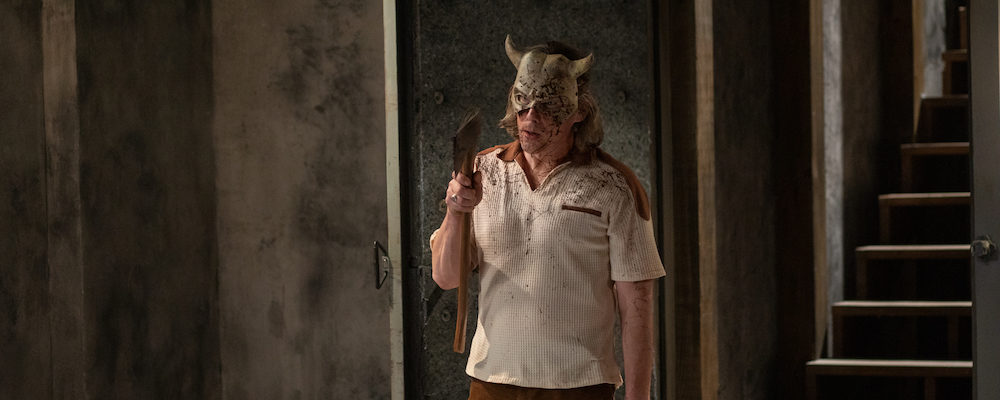‘The Black Phone’ Dials in Disturbing Atmosphere More Than Genuine Terror
Alci Rengifo
A movie like “The Black Phone” is another example of how studios like Blumhouse are bringing back the B-movie, polished for bigger box office returns than its ancestors. It’s based on a short story of the same name by Joe Hill, son of Stephen King and a keen reader will realize he has inherited his father’s talent for intense scares culled from simple, relatable situations. This movie adaptation by Scott Derrickson takes out much of the simplicity and adds new scares and nostalgia. Nostalgia is quite an overused word these days but “The Black Phone” is indeed part of the ongoing obsession to recreate the ‘70s and ‘80s. Cackling over this uneven but atmospheric movie is Ethan Hawke in one of his oddest recent performances where he indulges in a creepy side rarely seen from him.
The setting is 1970s Colorado under eternally gray skies. Our characters are straight out of King movieland. 13-year-old Finney (Mason Thames) plays baseball, deals with an alcoholic father (Jeremy Davies) and at least gets along with younger sister Gwen (Madeleine McGraw), who might have psychic dreams. Finney is also the target of vicious local bullies who only back away when he’s protected by brawler friend Robin (Miguel Cazarez Mora). A sense of dread hovers over the town when kids begin disappearing. Finney becomes the latest victim when he crosses paths with The Grabber (Hawke), an eerie man in black who rides around a dark van with black balloons. When he awakens trapped in a basement with concrete walls, Finney is nearly helpless as the Grabber, now wearing strange, demonic masks, makes bizarre statements about his intentions. Then, a black phone on the wall rings even after Finney is warned it doesn’t work. On the other end are voices that might be able to help him escape.
As an exercise in atmosphere, “The Black Phone” is convincingly moody and unnerving in terms of its images. Derrickson was originally known as a director of horror with films like “Sinister” under his belt before going over to Marvel and helming the first “Doctor Strange” movie. He’s capable of shocks and more intelligent scares, like his 2005 “The Exorcism of Emily Rose,” which balanced questions of demon possession from the angle of believing in it and another proposing it could be psychosis. “The Black Phone” shows Derrickson can still create unsettling images. Even when the dialogue lacks any solid insights into why the Grabber is who he is, the photography by Brett Jutkiewicz makes the character look truly menacing in the half light of his basement prison. In the Hill story the Grabber is a large man who is more of a nervous, deranged klutz. In the movie he’s just as crazy but turned by Hawke into a more classic serial killer menace, talking to Finney with a childlike voice and changing his mask from smiles to frowns. As a performance it’s a tricky feat since Hawke’s face is rarely seen. For 90% of the movie he’s wearing the mask expresses the madness with wavy hand gestures.
As soon as the black phone on the wall rings, the movie’s thriller aspect depends less on shocks and more on the tension of Finney trying to understand who is calling him and how he can escape. The voices seem to be coming from the beyond, in yet another nod to classic King story tools. There is also real tension in how Finney finds potential ways out of the basement but each one could lead to real danger, from options behind a dirty toilet to a bike behind a combination lock. Since the Grabber might pass out in his chair near the closest exit door, Finney’s choices are extremely limited. Much of this is added on to the original premise, so you can go read the short story by Hill and have a completely different experience. Juxtaposed with these moments are good ones with Gwen, who prays to Jesus for a sign to know where her brother is and isn’t afraid to snap back at the detectives who can’t seem to figure anything out. There’s also a mad conspiracy theorist (James Ransone), who alas is used in an absurd plot twist near the end.
Derrickson rides the nostalgia train with all of the usual elements as well. You get the cruel bullies who don’t shy away from punching a girl. One of the grabber’s victims is a long-haired rocker type who gets into fights at the local shops. Robin also tells Finney that he just has to see this great new gory movie called “The Texas Chainsaw Massacre.” What’s missing is the power of metaphor and richness of characters we find in the best stories of this kind, like Andy Muschietti’s adaptation of Stephen King’s “It,” also featuring a villain with balloons but aware it’s a parable about friendship and time. “The Black Phone” doesn’t feel like it’s about much more than the admittedly unnerving feeling of entrapment, or the sheer fear of being a kid captured by a maniac. Above all, it’s a memorable piece of retro visuals, with grainy sequences that feel pulled out of a lost ‘70s home movie intercut with the general film. The detectives do nothing other than appear on cue and even the alcoholic dad has no real function in the story except provide a good excuse for the kids to get out of the house. By the end credits at least the images linger much better than the scares.
“The Black Phone” releases June 24 in theaters nationwide.

